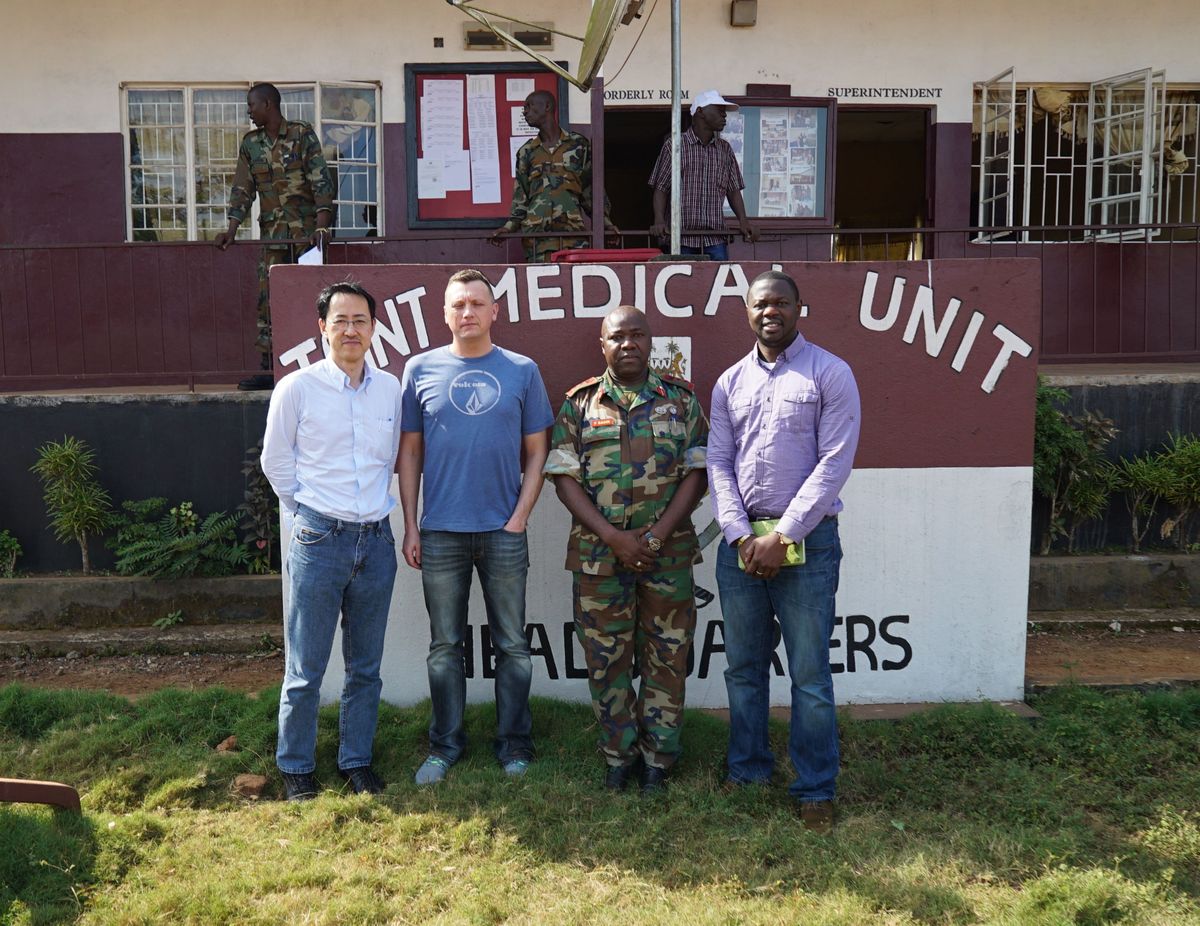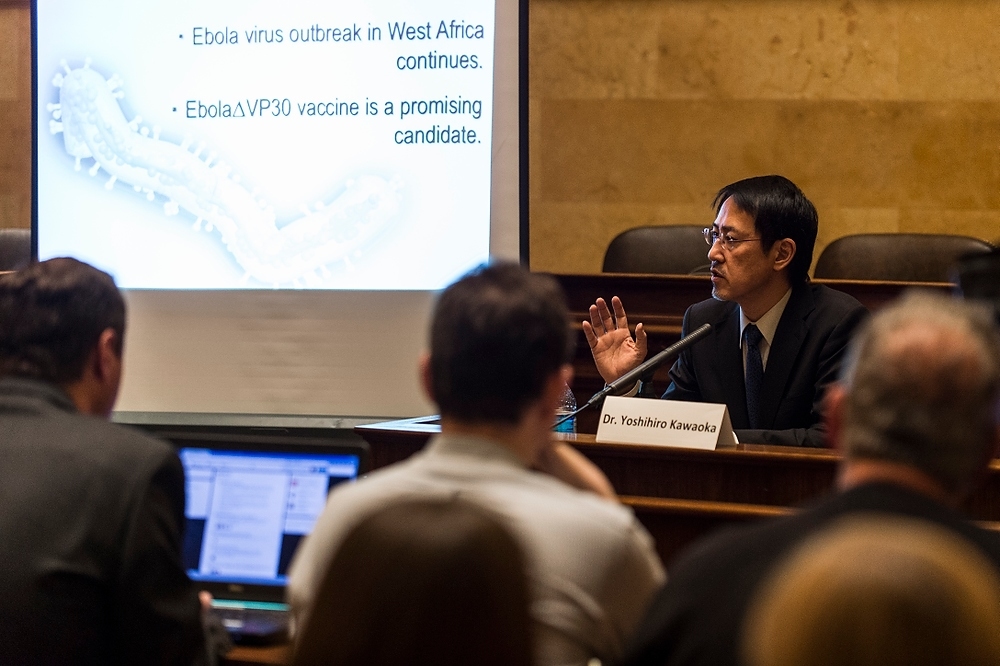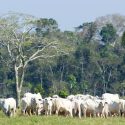In Sierra Leone, a chance to learn from Ebola

UW-Madison’s Yoshihiro Kawaoka, Peter Halfmann and Alhaji Njai stand outside of a military hospital with Foday Sahr, a Sierra Leone military official and chair of microbiology at the University of Sierra Leone. Ebola patients are treated at many of the country’s military hospitals like the Joint Medical Unit.
Photos courtesy of the Kawaoka Lab
When Yoshihiro Kawaoka and members of his research team first arrived in Sierra Leone in December 2014, the consistent wail of ambulance sirens was a frightening reminder that the Ebola virus was there, too.
It was what brought Kawaoka to the West African nation in the first place.
Kawaoka, a professor of pathobiological sciences at the University of Wisconsin–Madison School of Veterinary Medicine, started studying Ebola in 1995 after reading a book about the virus, “The Hot Zone.” He was fascinated by its origins and wanted to understand how it spreads, and how it sickens those it infects, so he could be part of the solution.
His studies had always involved common laboratory models, like mice and special cell cultures, and took place in high security laboratories like the National Institutes of Health Rocky Mountain Laboratories in Montana, where researchers gown up in airtight, spacelike suits and look at how these models respond to infection.
Now, he had a chance to study a disease in the very people who were living and dying with it.
“The sirens are going, on and off, and it was very scary — because that means Ebola patients are there — but at the same time we feel very fortunate to be able to do this work,” Kawaoka says. “We’ve never been able to do this with humans because we’ve never had human samples.”
Health workers tend to a patient at one of Sierra Leone’s military hospitals, where many of the country’s 8,000 Ebola patients have received treatment since an outbreak began in West Africa in December 2013.
Ebola virus first emerged in 1976, in Sudan and the Democratic Republic of Congo, in a village near the Ebola River, from which it gets its name. Over the years, the virus would emerge, sicken people and disappear into the forests again. But in December 2013, the outbreak that was to become history’s largest and deadliest was only just beginning.
“The Ebola virus is identified almost every year now, but it has been contained because it has happened in countries where Ebola virus appears consistently,” says Kawaoka. “This outbreak is different. This outbreak occurred in an area where we never had Ebola outbreak, so the local people did not know how to contain it. Developed countries did not recognize that until last June, when numbers of cases increased dramatically.”
By fall, the outbreak had reached a fever pitch, spreading to health care workers in Spain and the U.S., killing an African traveler in a Dallas suburb. Many of those infected came down with symptoms that ranged from fever and headache to bloody diarrhea and vomiting. Today, more than 10,000 people have died of Ebola in the current outbreak, including almost 4,000 in Sierra Leone, on Africa’s west coast. Nearly 26,000 have become sick.
But amidst the fear and tragedy, Kawaoka (who also holds an appointment at the University of Tokyo) saw opportunity. Almost a decade ago, he began working on an Ebola vaccine, designed using a form of the virus his research group created that could only grow in special cells contained in a high security lab. Before the current outbreak, funding for the project had dwindled as people had stopped thinking about the virus.
Kawaoka meets with Ekundayo Thompson, vice chancellor of the University of Sierra Leone, while in the African nation to establish a partnership to study and fight Ebola while improving the research capacity and infrastructure of the university.
Now, reinvigorated by the crisis, the Japanese government granted Kawaoka the money he needed to continue, and in March 2015, he published a study in the journal Science describing a vaccine shown to be both safe and effective in mice, guinea pigs, and nonhuman primates. That vaccine could be produced for clinical trials in the next couple of years, Kawaoka said at a public hearing at the Wisconsin State Capitol on April 21.
Throughout his career, first at St. Jude Children’s Research Hospital in Tennessee, and for the last 18 years at UW–Madison, Kawaoka has been interested in how influenza viruses and others, like Ebola, infect their hosts and make them sick. Ultimately, one of his goals is to create a universal flu vaccine that keeps people safe from that virus from year to year, and he also hopes to contribute to understanding how and why some influenza viruses become pandemic.
In 2012, he published a controversial study of the H5N1 virus, in which he showed just how few mutations it could take for the highly pathogenic avian influenza virus to become infectious in humans. That virus is now present in wild bird populations throughout the world, including the U.S., and virus strains harboring these potentially dangerous mutations have recently been found in Cambodia, he says.
In July 2014, Kawaoka’s team showed that a 1918-like pandemic influenza virus (Spanish flu) could be recreated once again in nature through the recombination of just eight viral genes already circulating in waterfowl.
But Ebola had eluded him. Until now.
A vial is labeled and prepared to hold blood from an Ebola patient in Sierra Leone. Researchers will compare blood from those who died of the virus to those who survived and those who never got sick to try to develop treatment.
After hearing of the current outbreak, Kawaoka asked if he could have some blood samples from Ebola patients. He heard nothing in response. Then in November 2014, he heard an interview on the UW–Madison campus with Alhaji Njai, a research fellow at the School of Veterinary Medicine and the Global Health Institute, and a native of Sierra Leone. Njai had begun a twice-weekly radio program to help educate his home countrymen on how to protect themselves from Ebola, and he was soon headed back for the holidays.
“We happened to be in the same department, but I had never met him. I contacted him and he immediately responded,” says Kawaoka. “We met to discuss whether we could do something in Sierra Leone and that was the beginning.”
It was just days before Christmas when Kawaoka and one of his most qualified researchers, Peter Halfmann, packed their bags and headed with Njai into the heart of Ebola territory, which was on mandatory lockdown.
“Usually there are people dancing in the streets,” he says, noting the somber tone that had settled on the colorful city of Freetown, Sierra Leone’s capital and its largest city.
Freetown is also home to the University of Sierra Leone, where Njai is affiliated, and the team toured the city, visiting military hospitals and holding facilities where patients were quarantined. They encountered police stops along the way.

Kawaoka speaks to legislators, legislative staff and media representatives in the North Hearing Room of the Wisconsin State Capitol about his lab’s work to develop a whole virus vaccine.
At the Madison hearing before reporters and policymakers, Kawaoka described how Sierra Leone is caring for its Ebola patients, isolating the sickest in bright rooms, providing the healing with fresh air. Health workers wear head-to-toe protective gear and masks. They incinerate materials from patient rooms and undergo a strict decontamination procedure after exiting patient areas, sprayed down with chlorine, standing in chlorine-filled buckets for five minutes, the process timed by other workers.
Sierra Leone has hired some of its Ebola survivors to work at these facilities. Many, tainted by the virus that has killed so many others, have been shunned by their families and communities, Kawaoka says.
Yet the death rate from the virus among people who receive proper care early in the course of infection — in Sierra Leone, this has involved treatment with malarial drugs, antibiotics and IV fluids — is now fewer than 2 in 10, he says. This is one of the things that surprised him most visiting the country.
“They save 80 percent of the patients and that is dramatic,” he says.
What they’re also saving in Sierra Leone is blood, the priceless material that Kawaoka hopes will unlock some of Ebola’s secrets.
“Now, we have samples to examine exactly what’s happening with humans infected with the Ebola virus and, by doing this, we should be able to find a way to control host responses and save patients.”
Yoshihiro Kawaoka
Kawaoka, who never entered patient areas himself, gave health workers in the military-run treatment facilities cameras encased in plastic and asked them to take photographs inside. The workers are also taking blood — a couple drops from each patient — packed in a tube inside a tube, wrapped in a bag.
These samples go to the researchers, who inactivate the virus and work in specialized biosafety tents in Sierra Leone, dressed head-to-toe in the same protective gear they use in the U.S. and Japan. They will spin down the blood in high-speed centrifuges, separating the plasma and the white blood cells, involved in immunity, from the oxygen-carrying red blood cells.
The researchers will look at the genetic and molecular signatures within these samples, comparing blood from patients who survived Ebola to blood from those who did not, and to those who never got sick at all.
“We have been working with influenza virus for many years, doing experiments in animals … to identify host proteins or genes that control the infections,” Kawaoka says. “We have tried to do the same thing with Ebola. Now, we have samples to examine exactly what’s happening with humans infected with the Ebola virus and, by doing this, we should be able to find a way to control host responses and save patients.”
Kawaoka and his team have now returned to Sierra Leone on multiple occasions and met with the country’s government officials and military and public health leaders, representatives from the World Health Organization (WHO) and the Centers for Disease Control and Prevention (CDC), and with representatives from the University of Sierra Leone.
Today, Kawaoka and Njai have embarked on a partnership, uniting their two institutions in the fight against Ebola. Kawaoka is trying to help the African nation develop the research infrastructure to continue to detect, study and prevent infectious diseases like Ebola. He is trying to raise the funds to bring this plan to bear.
In return, he will continue to study how Ebola impacts humans and how he might be able to help change future outcomes. While the current outbreak is subsiding, Kawaoka says this will not be the last.
“We have a choice: either not to do any work and see what happens — what happens in nature, whether we see outbreaks — or we study it and be prepared,” Kawaoka says. “It’s fortunate for us to have this opportunity and we very much appreciate it. It is important for people like us who are working on infectious disease to keep working during these outbreaks and continue to do this type of work.”



